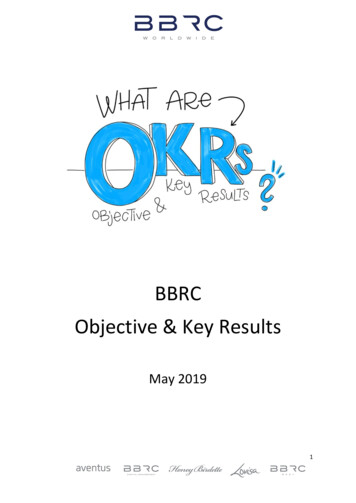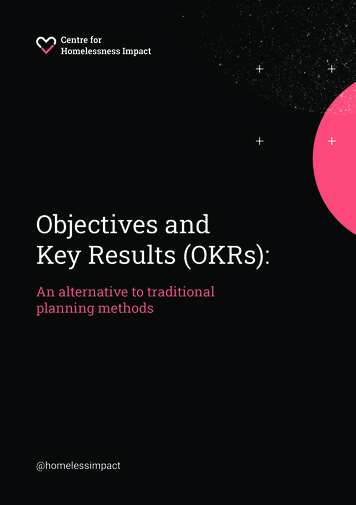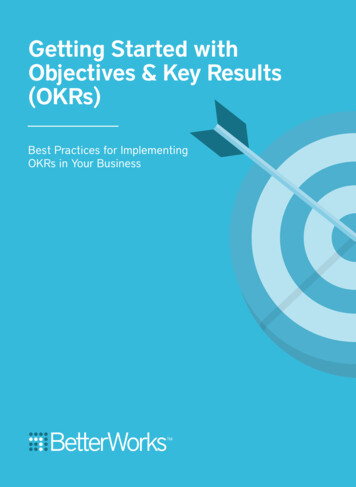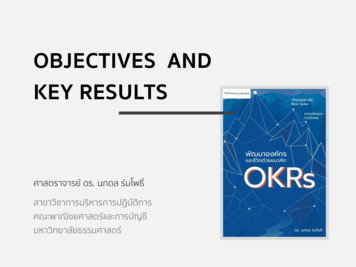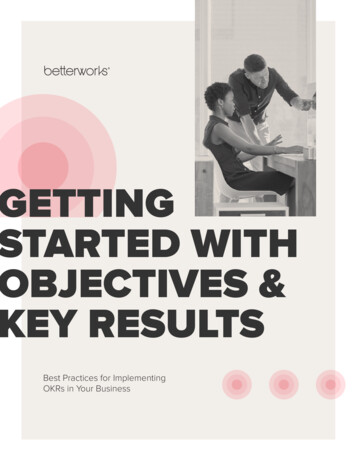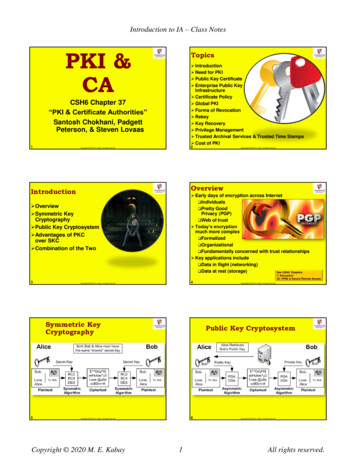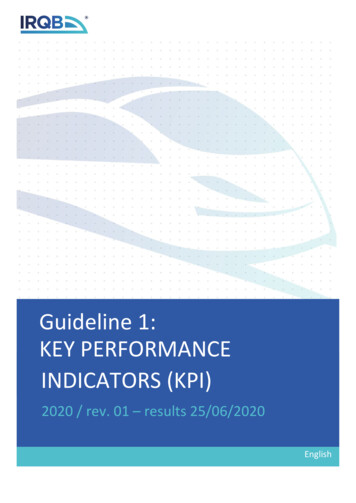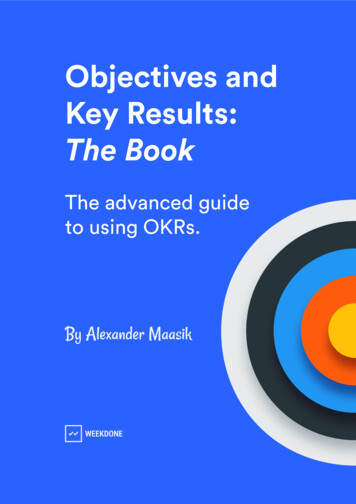
Transcription
Objectives andKey Results:The BookThe advanced guideto using OKRs.
Introduction1Benefits of OKR3Basics of OKR5Implementing OKRs73 approaches to implement OKR.8With a Pilot Team.8With top level management.9With the entire company.9OKR Champions.9Setting your first Objectives and Key Results.11Objectives.11Key Results.12Using OKRs Every Week14Weekly reporting.14Weekly meetings.16Monthly review.17Quarterly grading.17Yearly review process and OKR.19Common Mistakes and how to avoid them.21Having too many Objectives21Writing Project Plans instead of OKRs21Not updating progress on OKRs22OKRs and Other Performance Metrics23From KPIs to OKRs.OKR Software2325From spreadsheets to software.25Weekdone.27Moving forward28OKR examples29
Objectives and Key Results:The Book Using OKRs to win every day.IntroductionThere are many books and resources about goal setting systems thatpromise to get you from zero to hero. But the most effective methodology isthe famous Objectives and Key Results (OKR).Way too many people read something, watch a Youtube video, or attend aconference and get hooked on OKR. Only to fail using it as there was nothingto really help them get from point A (“OKRs will solve my problems”) topoint B (“We are actually seeing results. Yay!”).While most books teach you the basics of OKR and the benefits ofimplementing it in your company or team, very few of them actually takeyou through the journey of implementing the system.So this book is about that. Getting from knowing OKRs to using OKRs.From the What to the Why and How. It’s best to know a little about themethodology before reading this book (although we do cover the basics). So,if you don’t know what OKRs are, just Google it (seriously, they are great atusing the system). Find out how Google implemented OKRs. Read about JohnDoerr’s experiences on promoting it. And then get ready to succeed with thisbook.1 / 30
Objectives and Key Results:The Book Using OKRs to win every day.The startup Sam had founded with two years ago their friend, Mike, was doingwell. The organization was growing slowly, had 10 wonderful employees, andmost employees were happy. There was no danger of running out of money.However, progress had remained roughly the same for 12 months. There was noexponential growth and the energy that had once been there had faded.Last week an investor forwarded a newsletter to their Slack chat, promotingObjectives and Key Results. This goal setting methodology was supposed to helpcompanies stay focused, grow, and “solve all the world's problems”.Sam was feeling skeptical. Yet, knowing you can’t succeed if you close yourmind to new ideas. Sam decided to do some research and find out the benefits ofthe system and try it out in their company.2 / 30
Objectives and Key Results:The Book Using OKRs to win every day.“Seeing what people are doing and having anautomated report is a value in itself.”Andrew Nelson -Exxact CorporationBenefits of OKRIf you’re reading this book you’re probably already familiar with thebenefits of the methodology. You already know that writing goals down andcommunicating them well greatly increases the likelihood of achievingthose Objectives. But there are many more reasons to start using OKRs.Always know what’s happening in your team. OKRs show you at a glancewhat is happening in your team and company. Key Results let you know thestatus of everyone’s Objectives.You can make more informed decisions. When using OKRs, you canquickly see when an indicator underperforms, so you can be proactive andtake action before any problems arise.3 / 30
Objectives and Key Results:The Book Using OKRs to win every day.Focus on the work that matters. With OKRs you’ll know what needs to beaccomplished each week and quarter as well as who is responsible for it. Thiswill keep large company and team Objectives in focus so everyone can plantheir day and week with the company vision in mind.If there is one leadership and team management practice every leadershould implement, it's OKRs. It's lightweight as it consumes very little timeor resources, and it provides countless benefits for your productivity, focus,and company culture.4 / 30
Objectives and Key Results:The Book Using OKRs to win every day.“The process of OKRs helps companiesenvision what success looks like.”Henry Mason - Managing Director of TrendWatchingBasics of OKRUsing OKRs is hard work. Anyone who says otherwise, is trying to sell yousomething. If you think adopting OKRs will just magically make all yourproblems disappear, you might want to get ready for disappointment. So,why should you even try?My pitch for getting people to start using OKRs is very simple. Using OKRwill make you happy. OKRs make employee’s lives easier by helping themunderstand what they need to do and why their work has meaning. It alsolets them have more control over their day-to-day work.5 / 30
Objectives and Key Results:The Book Using OKRs to win every day.According to a customer survey we conducted, an average Weekdone useris two times more engaged than the average employee in the US and 6 timesmore engaged than the average employee worldwide (employee engagementrate in the US is 30% and 13% worldwide).Employees using OKRs are more engaged because they have a betterunderstanding of their role in the company. They know where their team isheading and what is expected of them. This decrease in confusion anduncertainty help them contribute more and live less stressful lives.OKRs are usually a part of a recurring quarterly planning and progressreview process. While the majority of OKR usage is quarterly, somecompanies also set annual or monthly OKRs. In all cases, OKRs are keptpublic in front of everyone, so people and teams can move towards the samegoals and know what others are focusing on.OKRs consist of a list of 3-5 high-level Objectives. Under each Objectiveyou then set 3-5 measurable Key Results. Each Key Result has a progressindicator or score of 0-100% (or 0 to 1.0) that shows its achievement.You can also use Weekly Reporting or Weekly Initiatives to show thetasks you are working on to advance your Key Results.While it sounds clear in theory, there are a lot of hurdles you need toovercome to implement the system in your team. We’ll cover those as youread more.6 / 30
Objectives and Key Results:The Book Using OKRs to win every day.“Without Weekdone, it would be very hard forus to manage our Objectives, so I consider it to behighly valuable for us.”Scott Wolfe Jr. - CEO of zlienImplementing OKRsThere are many OKR resources out there. Many books, that promote themethodology. But most of them lack practical examples on how to actuallyget OKRs to work. This is the most important part of this book. It isimplementation guide.As they were only a team of 11 people, Sam decided to try out OKRs with theentire team for two to three quarters to see what would happen. After all, most ofthe research suggests that using them for a shorter period of time is useless.Before implementing the system, Sam needed to become an expert. Someonewho could answer any question others may have and address any confusion a newgoal setting methodology might bring.Sam also decided to use an OKR software right away instead of trying themfirst with spreadsheets or some other analog way. OKR softwares are usuallyeasier to use and they have customer support who is invested in making sure youuse the system effectively and get results with it.They will help you withonboarding, OKR training, and anything else your team might need.7 / 30
Objectives and Key Results:The Book Using OKRs to win every day.3 approaches to implement OKR.After you have made the decision to implement OKRs, decide whichpeople and teams will use this system in your organization. There are manydifferent ways you can start using it. You must decide which one is the bestfor your company and team.Pilot Team Easy way of testingif OKRs might work for yourcompany See how OKRs willwork with a full team Work out any issuesbefore rolling it out to otherteamsTeam Leaders Only Simplest way ofstarting to implement OKRs OKRs on theCompany level and Teamlevel to start Lack full overviewof how OKRs will work witha full teamEveryone Best for SMEs orcompanies with flathierarchies Most difficult toimplement Get full value muchfasterWith a Pilot Team.Some companies choose to first roll out OKRs to only one team in thecompany before rolling it out to subsequent teams. This can be a good way towork out any kinks in your OKR cycle before rolling it out to everyone.With this approach, a small team (and their manager) will go through anextensive training on how to use OKRs They will try the methodology out fora quarter or two and then find the best way the system works for yourcompany’s needs.The main benefit of this approach is that by the time you startimplementing goal setting throughout your entire organization, you’ll havea enough OKR experts inside your teams to answer any questions.The downside of this approach is that it will take longer for yourorganization to get the full value out of the methodology.8 / 30
Objectives and Key Results:The Book Using OKRs to win every day.With top level management.Other companies prefer to initially roll out to team leads and managers tosimplify the process. You can set company level OKRs and team level OKRsfirst, before rolling out Personal OKRs. The main benefit here is thatmanagers and team leads will be very involved in the OKR process. Thedownside to this method is the same as the previous method: it will takelonger to get everyone on board.With the entire company.Implementing OKRs with everyone at once can seem like a daunting task,but in SME’s or companies with flat hierarchies, it can work quite well.The implementation process starts with leadership training, followed byemployee training, and then establishing one or more OKR champions inyour company. When everyone is informed enough, Objectives are set and allyour teams start measuring their Key Results at once.However, no amount of training makes this transition perfectly smooth.It will still take two or three quarters for everyone to use the methodologyright and for it to deliver results. So if you are committed to OKRs, you needto test the methodology out for at least a year.If you do decide to start with everyone right away, it can be easier to juststart with company level and team level OKRs while having individuals focuson updating their weekly plans.OKR Champions.When deciding to implement OKRs in your company, you should assign ago-to person, who will be responsible for learning all there is to learn aboutthe methodology. We call them OKR champions.9 / 30
Objectives and Key Results:The Book Using OKRs to win every day.OKR Champions are responsible for making sure everyone adapts thenew methodology, takes charge of educating the team, and makes sure noone falls behind.That person will help you onboard other employees and answer theirquestions. They will also be responsible for making sure, other employeeswill set OKRs and update their Key Results regularly.It can take a lot of time to master the ins and outs of OKRs to become atrue OKR champion.Sam told everyone about the new system a month before they were supposedto start using it. They were well-prepared and, surprisingly, excited.Like expected, people were confused. And a little scared. Change is alwaysscary.“How will it affect me?” was the question on everyone’s mind.Having read all the books, Sam had the answer. “It will make your life easier.You’ll always know where we are going and what we are doing to get there.”“Will we have to spend much more time on reporting, wasting the time wecould be working?”“No,” Sam knew: “you’ll actually spend less time on reporting and makingplans. The only time consuming part will be setting the OKRs themselves. But formost of the quarter, you’ll actually spend less time on meetings or sharinginformation with others. You’ll have a chance to do more meaningful work.“10 / 30
Objectives and Key Results:The Book Using OKRs to win every day.Setting your first Objectives and Key Results.The first question that comes up is: should defining the OKRs happenbottom-up or top-down?There is no wrong or right way in this case. Sometimes uppermanagement or the CEO outlines the company OKRs first and then asksteam managers to set their team goals in accordance with the companyObjectives, followed by personal employee goals based on team Objectives.This approach is better for making sure all goals align with your company’svision. It is good to have the CEO say, “this is where we need to go. You needto figure out how your work will get us there.”When you start by setting personal goals, employees have more inputand they will be more invested in their work. But of course this doesn’t meaneveryone just does what they want. It requires a lot more discussion at theteam level to come up with personal and team Objectives and then explainwhy these are the right Objectives to the C-suite.In the end, the process moves both ways. You need to go over thecompany level Objectives and personal Objectives many times before theywork well together. That is all part of the process of setting and aligninggoals.Objectives.Setting the right Objectives is key. If you get this part wrong, it will take alot of energy to fix the system afterwards.Objectives should be qualitative and describe the desired outcome. Forexample: Understand customer needs. There is no need to have metrics foran Objective (you’ll have those with Key Results, but that we’ll discuss alittle later.).11 / 30
Objectives and Key Results:The Book Using OKRs to win every day.You can see examples of different Objectives for different teams at theend of this book.The main characteristics of Objectives: Actionable : Objectives should be goals that a person or a team canexecute independently. Inspirational : They should excite employees and give them a reasonto be excited on Monday morning when going to work. Time Bound : OKRs should be set quarterly so that people can getthem done as fast as possible.Key Results.Key results measure how far from reaching your Objective you are. Itadds metrics to Objectives. The easiest way to set Key Results is to follow theSMART model. SMART is a methodology that sets criteria to the tasks youset.The KRs must be Specific, Measurable, Achievable, Relevant, andTime-bound. This is called the SMART model.SMART goals are: Specific : is the KR well-defined and understandable for everyone? Measurable : can you measure success or failure? Achievable : is it realistically possible to do? Relevant : is this KR important for your Objective? Time-bound : have I clearly established when the goal must be met?For OKRs this time is usually one quarter.You can take a look at some great examples of both Objectives and KeyResults at the end of this book.12 / 30
Objectives and Key Results:The Book Using OKRs to win every day.Setting Company Objectives was easy for Sam. The company needed to grow 3times in 12 months. That meant increasing revenue, growing the team andimproving their product.But how to do it, how to measure progress towards that goal, was a lot hardernut to crack.Sam couldn’t just tell the sales team to sell three times more. If they had knewhow to do that, they wouldn’t be in this situation.Sam decided to discuss this with their entire team. So they took 2 days off andorganized an team offsite to discuss and review their work and come up withideas on how to best implement the OKR.The solution was to focus on research and experiments for the first quarter. Tosee what aspects of their day to day work could be improved.For Sales the Objectives they decided on were “Improving internal processes.”For marketing, it was to “Get an understanding of our customers needs.” Samherself set an Objective to “Build Company Culture.” Sam wanted to start withhiring new people but during the offsite they realized there’s no point in doingthat before the research is complete and they know where their growth will comefrom.After the Objectives were set, each team themselves came up with their firstKey Results. And they discussed all of them as a group. That way everyone had aclear understanding about what to do. This also made sure Sam, their OKRchampion, could make sure everyone is on the same page.13 / 30
Objectives and Key Results:The Book Using OKRs to win every day.“Real-time reporting is very important forretrospective reasons and to see what is going on,if other teams have problems, I can help.”Toby Young - CTO of EburyUsing OKRs Every WeekAny goal setting methodology only works if you are willing to commit toyour goals every day. Luckily, OKR was designed so that you can’t ignoreyour goals. This is one of the main reasons it is better than the yearly reviewprocess many companies still commit to.You need to set your Objectives every quarter. You must update your KeyResults every week. And you must make sure your day to day tasks move youtowards your goals.Weekly reporting.In order for OKRs to work you need to keep measuring your KRs everyweek. You must make sure that you, your team, and your company are allalways moving towards your goals.The best way to do this is to use a weekly reporting methodology calledPlans, Progress, Problems (PPP). PPP is a best practice managementtechnique for recurring (usually weekly) team progress and status reporting.PPP works as initiatives or tasks for your Objectives. This makes sure all ofyour tasks are focused on accomplishing your long term goals.14 / 30
Objectives and Key Results:The Book Using OKRs to win every day.'Weekly status reporting consists of 3 different questions or categories.Each person reports 3-5 achievements, goals, and challenges. Plans . What are you planning? (Future) Done . What have you accomplished? (Past) Problems . What problems are you facing? (Present)Each week employees answer these questions (without writing longessays) and a manager can get an overview of what's going on. When usedwith OKRs, it’s important that each of your tasks under Plans is linked to oneof your Objectives. That way, you can be sure that your work contributes toyour long-term goals. And, while tasks might seem important, not beingable to link it to a specific goal, means, you might need to rethink itsimportance.15 / 30
Objectives and Key Results:The Book Using OKRs to win every day.Filing reports is a time killer that draws people away from actuallybeneficial tasks. Still, without reporting, companies will fall into chaos.Knowing what is going on in your team is the only way to make goodbusiness decisions and plan work in the long run. That’s why you need toturn weekly reporting into a smooth and easy process where employees willnot even notice that they’re filling out reports.Weekly meetings.Weekly status meetings are required to make sure you and everyone inyour team are moving in the right direction with their goals. After all, OKRsneed to be public, so it’s important for employees to know what others areworking on.If you are running a small start up, weekly meetings can be for the entirecompany. But more commonly, they should be done at the team level todiscuss how the team is doing.16 / 30
Objectives and Key Results:The Book Using OKRs to win every day.Monthly review.Once a month, you should have a meeting to discuss company levelObjectives and how the teams are supporting those Objectives through theirOKRs.This is the time to identify any red flags and brainstorm ways of fixingthem before the quarter ends. Ideally these meetings should take placebetween the company and team leads, and team leads and their directreports.Quarterly grading.There is a very important aspect of OKRs that a lot of people get wrong.You don’t grade your Objectives, you grade your Key Results.Objectives are meant to be inspirational goals that keep everyone alignedand inspired. Key Results are the measurements you need to pay attentionto.There are two main ways to grade OKRs at the end of the quarter. Eitherby looking at KRs and seeing how much was accomplished (giving a % value)or by a binary system. Whichever way you choose it is vital that beforestarting using the system, everyone knows how they’ll be graded.When you measure OKRs by percentage of completion, it is veryimportant to remember that OKRs are meant to be hard, and completing aKR 100% should be difficult to achieve.17 / 30
Objectives and Key Results:The Book Using OKRs to win every day.A standard model for how OKRs should be set up would look like this.You can also go with grading Objectives by adding a binary “done-notdone” mark on it. This commonly used model states that an Objective isdone if you complete all the KRs. So, if you had 3 KRs and didn’t hit the markon any of them, the Objective stays at 0.This approach tends to reduce morale and increase confusion as OKRs areoften set very high and the risk of failure with some KRs is not only commonbut expected. KRs must always be measurable, and you need to figure outthat criteria when setting them.It is very common to finish your first quarter with mostly 100% or withmostly zeros, especially if you had no prior experience in setting OKRs. It’simportant to remember that OKRs are not a project you run for 3 months. Towork well, they must be used constantly and the progress must be improvedevery quarter. In 3 or 4 quarters, you should have a clear idea on how theywork and most of your KRs should fall into the 70% category. Then you’re allset.18 / 30
Objectives and Key Results:The Book Using OKRs to win every day.Yearly review process and OKR.Companies have used the yearly review process to evaluate employeeperformance for decades. But it is safe to say, that for most companiestoday, the system is too slow and time consuming.That said, you can use OKRs to set annual goals. As long as you stillupdate your progress weekly and review (and modify) it monthly. Still, it isbetter to only do it on a company level. For team’s and personal OKRs, ashorter period of time is better. Otherwise you lose one of the mostimportant psychological aspect of OKRs: urgency.Yearly Objectives will always seem more abstract, more unreal. For manyemployers, they are not something one should worry about in February.Also, as OKRs are meant to be ambitious, yearly Objectives are more likely tofail.19 / 30
Objectives and Key Results:The Book Using OKRs to win every day.For the first few weeks Sam had to remind everyone personally to update theirKRs on Friday (the day they had agreed to do it) but afterwards it got easier.Seeing progress every week improved morale and cut the time spent on weeklystatus meetings by half. Moreover, for the first time, Sam knew what everyonewas working on without spending time chatting with everyone.After 4 weeks, Sam called an all hands on deck meeting to discuss companyprogress. While Marketing was on track, the Sales team was struggling with theirObjective (improving the sales process) and dealing with customers. This feedbackhelped Sam to decide that they need to hire more salespeople (an OKR for nextquarter). But for now they decided to remove one of the KRs from Sales, so theycould better manage their time and still generate revenue.This is a normal adjustment when setting OKRs for the first time. After all, youdon’t know your limits before you try something. It’s better to set to high KRs andObjectives and fail rather than setting the bar too low.By the time the quarter finished, most teams had finished about 60% of theirKRs. But still, they now had a good understanding of who their customers were,they had a faster sales process, and Sam knew how and who they needed to hirenext.In quarter two, more progress was made. In time, updating KRs became ahabit for everyone and the growth Sam had visioned became a reality.By the fourth quarter, growing 3 times larger no longer seemed like anambitious enough a goal.20 / 30
Objectives and Key Results:The Book Using OKRs to win every day.“OKR process is very good for us andWeekdone is a good tool to manage that.”Scott Wolfe Jr. – CEO of zlienCommon Mistakes and How to AvoidThemThere are many pitfalls both new and experienced OKR users might fallfor. It is good to go over this list every time you set new OKRs to make sureyou are not making rookie mistakes.Having too many Objectives.You might find that at the end of the quarter, you haven’t made muchprogress on any of your Objectives. This could be because you have dividedyour attention among too many different Objectives. It’s important thatwhen you’re writing your Objectives, you try to limit yourself to no morethan 3 Objectives per team and 3 Objectives per person.The first time you set OKRs it can be hard to prioritize what’s mostimportant because everything can feel like it’s important! However, havingtoo many Objectives can mean you’re spreading yourself too thin and notfocusing enough on any of your goals. Keep it simple and you’ll find thatyou’re actually able to achieve more.Writing Project Plans instead of OKRs.Upon reflecting on your OKRs, you might realize that most of your KRswere binary. You either completed them 100% accomplished or nothing atall. In these cases, it’s most likely you didn’t follow proper methodology21 / 30
Objectives and Key Results:The Book Using OKRs to win every day.when writing your OKRs. When most people start using OKRs, they oftenwrite an Objective that’s actually a project, and write KeyResults that are actually tasks for that project. To correct this, thinkabout the outcome you want to achieve from the goal you have set and try tofind ways to measure those outcomes. If you must have a binary Key Result,try to measure it by phases and milestones.Not updating progress on OKRs.Another common mistake people make is not updating progress of OKRsregularly. It’s important to update the progress of your OKRs on a weeklybasis, otherwise you may reach the end of the quarter and realize you haveno idea if you achieved anything at all. To prevent this, you shouldimplement a weekly cycle or ritual for everyone in the company to access theprogress of their OKRs.Ideally, OKRs should be updated and discussed within teams once a week.Weekly meetings also allow you to address an problems with your OKRs thatmay have occurred and brainstorm on how to fix them before it’s too late.If things did not go perfectly during the first quarter, don’t give up! Mostcompanies run into a few problems and roadblocks their first time usingOKRs. It’s perfectly normal to not do everything right, or even anythingright, the first quarter you try to implement OKRs. Implementing OKRs is aprocess and requires a lot of time, dedication, and a shift in mentality.22 / 30
Objectives and Key Results:The Book Using OKRs to win every day.“If you are using an OKRs based managementapproach, Weekdone is the best tool I have seen.”Lyle Stevens - CEO of MavrckOKRs and Other Performance MetricsFor most people, OKRs are not the first time you set goals. Almost allcompanies have some sort of review process in place and every CEO has along term vision that they are working towards. Implementing OKR is notjust using an entirely new system, but it is a better way to structure andmanage the goals you had before.From KPIs to OKRs.Key Performance Indicators (KPIs) exist in most companies. You mayhave used them for years in your own team. However, often when the teamand company grow, KPI based tracking stops being satisfactory.KPIs help you track work but they don’t inspire your team and they don’thelp you stay focused. That is why, a lot of smart leaders are following thelikes of Google and have started looking at Objectives and Key Results (OKR)methodology.It may be quite hard to see the difference between KPIs and OKRs. If youare using KPIs now and want to move to a OKR based goal setting, your firstinstinct will probably be to just use your KPIs as Objectives.While KPIs are measurable, Objectives are not. In the OKR system youmeasure Key Result that help you get to your inspirational Objectives. Thatmakes the move from one system to another tricky as you can’t justcopy-paste your KPIs.23 / 30
Objectives and Key Results:The Book Using OKRs to win every day.It is important to remember that while KPIs are metrics. Objectives needto be inspiring and easy to remember.To make sure you get the transition from KPIs to OKRs successfully, usethis 3 step plan to help you. The 3 steps are easy to follow and foolproof:Step 1: Set Objectives. Objectives in OKR are not metrics and so can’t becopied straight from KPIs. What you need to do is look at your KPIs andgroup them into captivating goals.Step 2: Copy KRs from KPIs . When your Objectives are set, you can attachyour old KPIs to them as Key Results. Make sure you don’t have more than 3KPIs attached to a single Objective. Otherwise, you’ll be overwhelmed. AsOKR coach Felip Castro has said, the fewer Key Results you have, the easierthey are to follow: “Even so, no team should have more than 10 KRs – and Iam not saying that every team can have 10, the fewer, the better.”Step 3: Make sure your KRs are worded correctly . The easiest way to setKey Results is to follow the SMART model. SMART is a methodology thatsets criteria to the goals you set. The Key Results must be Specific,Measurable, Achievable, Relevant, and Time-bound. The questions you needto ask for each goal are: Specific: is the KR well-defined and understandable for everyone? Measurable: can you measure success or failure? Achievable: is it realistically possible to do? Relevant: is this KR important for your Objective? Time-bound: have I clearly established when the goal must be met?For OKRs the time is usually one quarter.24 / 30
Objectives and Key Results
Objectives and Key Results:The Book Using OKRs to win every day. Introduction There are many books and resources about goal setting systems that promise to get you from zero to hero. But the most effective methodology is the
